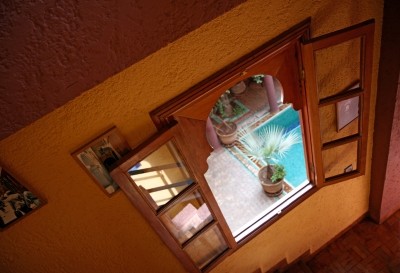Contrasting textures are a notable feature in Moroccan design and unvarnished wood is used extensively, alongside smooth and glossy tiled surfaces.
Large wooden chests and sturdy tables adorn many of the rooms, in addition, some of the seating usually contains exposed wooden bases. Even though the wood used often has a somewhat rough texture, it is usually ornately carved and decorative. Typically, woods such as argana, cedar and lemon are preferred by craftsman, due to their quality and suitability for making furniture.
In accordance with Islamic law you will not find images of living things such as animals or humans incorporated into any design or furnishing, nevertheless, great attention is given to detail, and textures are all important in Moroccan interior design. Beautifully coloured tiles in geometric designs, known as zellinge, are often a central feature in many rooms and demonstrate just how much care has gone into creating the right effect.
Zellige is a form of tilework, similar to a mosaic, a Zellige is made using tiny coloured chips which are set into plaster and then covered with enamel, which gives a smooth and somewhat glossy appearance. The level of detail involved in Zellinge is really quite breath taking, and when used to decorate a room can create an almost palatial space. Zellinge and other forms of tilework can be found on floors, walls, in bathrooms, on table tops, around doorways and on fountains. For various reasons, you may not wish to have your walls covered with tiles; to create a more subtle effect, consider using tile topped tables, or tiled wall art.
Tadleakt is a type of lime plaster which is frequently used to decorate walls both internally and externally. The plaster is polished and then treated with abrasive materials or stones which gives a soft, smooth appearance. Tadleakt can also be used in wet rooms and bathrooms.
The fabrics used in Moroccan design tend to be sheer or lightweight. Silk and satin cushions and drapes are frequently found in Moroccan homes, or used as throws to cover seating. When choosing fabrics to decorate your room, opt for transparent fabrics or those which are smooth to the touch.










 A Colorful Journey: Comparing and Contrasting Mexican Folk Art With Polish Folk Arton 09/05/2024
A Colorful Journey: Comparing and Contrasting Mexican Folk Art With Polish Folk Arton 09/05/2024
 Exploring Traditional Japanese Tapestry Landscape Art: A Window into Nature’s Serenityon 09/01/2024
Exploring Traditional Japanese Tapestry Landscape Art: A Window into Nature’s Serenityon 09/01/2024
 Are Border Collies Really the Smartest Dog Breed?on 08/20/2024
Are Border Collies Really the Smartest Dog Breed?on 08/20/2024
 A Writer's Guide To Wizzley- A Gem of A Bookon 04/10/2013
A Writer's Guide To Wizzley- A Gem of A Bookon 04/10/2013


Comments
Thank you for your comment below, in answer to my previous observation and question.
Dustcloth, mild detergent and water sound so effectively sensible, so sensibly effective.
What cloth material -- since some would streak -- would be best?
Hi DerdriuMarriner!
I think it depends on the type of Moroccan tiles. They're often sealed but some tiles are porous beneath the seal so harsh detergents are not recommended. I understand that dusting off any debris and using a mild detergent and water is the safest way to clean them.
Moroccan-style tiles and wood catch my attention.
Might there be Moroccan-style techniques for keeping such materials authentic and clean and impactful-looking?
Hi Brenda,
I love colour, too. I'm really attracted to the dark fushia and the orange gold cushions. Think they're next on my wish list. :)
I'm a color addict, and I love those colors. Interior design is one of my passions. Thank you for the delightful article.
Hi Sheri,
I absolutely love Marrakech, the architecture is stunning and the colours! The Moroccans certainly know how to decorate, and they put so much detail into all the furnishings. Mirrors, lighting, wall art, everything is pleasing to the eye.
When I visited a colleague at his mother's home in Marrakech, I was most impressed with the wood fittings on the walls - the carving was so intricate. Your article brought back good memories of a remarkable place.
Hi Arlene,
I visited Marrakech a couple of years ago and fell in love with the colours and designs. I also recently helped my sister re-decorate her house in the Moroccan style, it is so beautiful. Now her's is complete I'm starting on my own home, bathroom first, then the remainder of the rooms!
Hi Dustytoes,
Moroccan style is lovely isn't it, decadent and luxurious!
The Moroccan style of decorating is so beautiful!